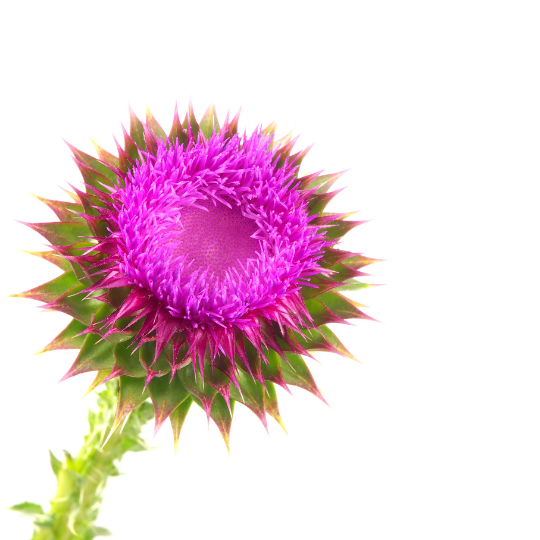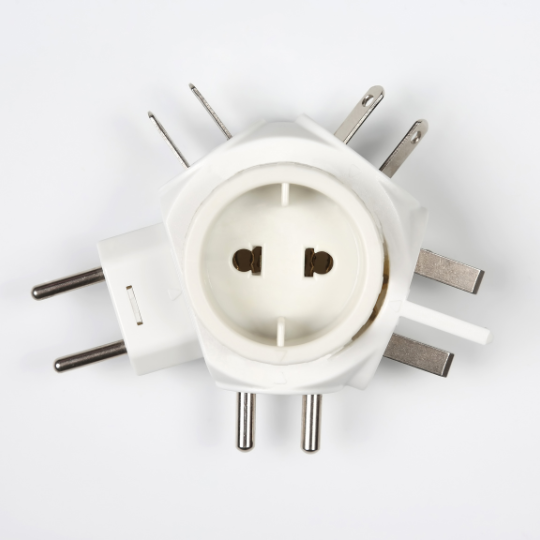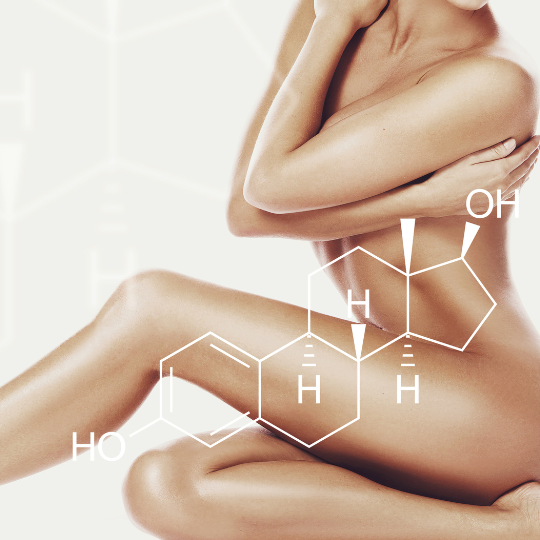Excitotoxicity: Inflammation manifesto
Glutamate is an abundant amino acid established as the most essential neuromodulator of the central nervous system (CNS). It is essential to many physiological functions of the body, such as learning, memory, and energy metabolism. However, when glutamate’s levels become too high, it can lead to a condition known as Excitotoxicity. Glutamate excitotoxicity occurs when the neurotransmitter’s homeostatic balance is disrupted and levels in the extracellular fluid become elevated. But what does excitotoxicity cause? It can lead to inflammation and damage to cells and tissues in the body, including brain damage (Jia et al., 2015).
Glutamate and its primos: GABA, glutathione, glutamine and alpha KG
But how is Glutamate produced and metabolized in the body? Glutamate is related with other amino acids that might sound familiar to you, such as glutamine, alpha-ketoglutarate (aka alpha KG), GABA, and glutathione. The relationship between glutamate and all this other compounds is also related to excitotoxicity and inflammation. For example, glutamine is a precursor of glutamate, and its conversion to glutamate is an important step in the metabolism of nitrogen. Alpha-ketoglutarate is a byproduct of the conversion of glutamate to glutamine, and It can be used to synthesize other amino acids and compounds that are high in energy. Gamma-aminobutyric acid (aka GABA) is an inhibitory neurotransmitter that bocks glutamate’s excitatory effects. And last but not least, Glutathione, the antioxidant by excellence, helps protect cells from oxidative stress and inflammation.
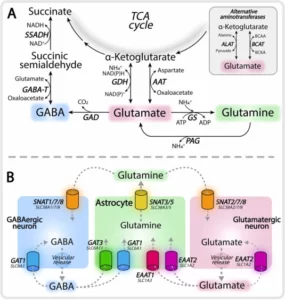
Excitotoxic inflammation deconstructed
We talked about excitotoxicity, but let’s dive a little bit more into its mechanism. As mentioned, excitotoxicity occurs when there is an excess of glutamate in the CNS, which overstimulates neurons and causes an excessive amount of Calcium to enter the cells. This can lead to inflammation and cell death.
Excitotoxicity can be caused by numerous conditions, including brain injuries, strokes, and neurodegenerative diseases, like Alzheimer’s and Parkinson’s disease. Additionally, it can be triggered by situations like persistent stress, anxiety, and depression that throw off the glutamate and GABA balance. Glutamate and the associated amino acids it interacts with also play a number of roles in excitotoxicity and inflammation:
- For one, they cause the activation of NMDA receptors (NMDAR), a subtype of glutamate receptor located on the surface of neurons. The activation of NMDAR by glutamate, permits calcium ions to enter the cell, which activates enzymes that might result in cell death and inflammation (Jia et al., 2015)
- Another mechanism is through the production of Reactive Oxygen Species (ROS), which are extremely reactive chemicals that can lead to oxidative stress and inflammation. The overproduction of glutamate and the activation of NMDAR can both lead to the production of ROS. Inflammation and cells death can result from the damage that ROS cause to DNA and proteins.
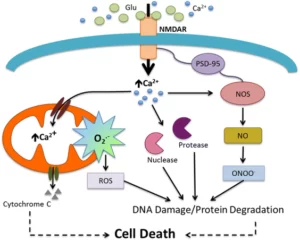
But here is where super Glutathione comes into play. Glutathione plays a crucial role in protecting the body from excitotoxicity and inflammation by neutralizing ROS and other free radicals, it can also reduce inflammation, repair DNA and proteins damage (Read more about Glutathione: or for a brief summary check our previous article on this master antioxidant)
Genetics? Do they play a role in excitotoxicity?
Single nucleotide polymorphisms (SNPs) can raise the risk of the body producing too much glutamate. Some examples are:
- GAD (Glutamate decarboxylase) enzyme converts glutamate to GABA. Having high glutamate conditions and variants in GAD gene, can derive in high glutamate and low GABA concentrations, related to increased stress and high glutamate, causing excitotoxicity. (rs1181224255, rs1051390481, among others).
- GLUL (Glutamate-ammonia Ligase) is an enzyme that catalyzes the synthesis of glutamine from glutamate and ammonia in an ATP-dependent reaction. Polymorphisms in the GLUL gene can derive to glutamine deficiency. (rs1650179029, rs80358214, among others)
- GLS (Glutaminase) is an enzyme that catalyzes the hydrolysis of glutamine to glutamate and ammonia. Polymorphisms in GLS gene can cause accumulation of glutamate in the system. (rs1558972120, rs1558971345, among others)
- GSS (Glutathione Synthetase) is an enzyme that catalyzes the second step of glutathione biosynthesis, which is the ATP-dependent conversion of gamma-L-glutamyl-L-cysteine to glutathione. Variants in this gene can derive to Glutathione Synthetase Deficiency and thus to chronic inflammation, and cell damage. (rs121909307, rs121909308, etc).
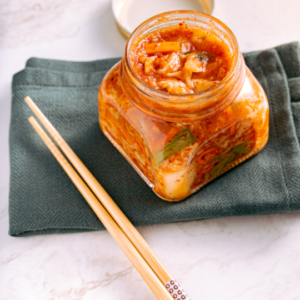
Regulating Glutamate in your body
There are some lifestyle changes that you can make to minimize excessive glutamate levels, the risk of excitotoxicity, inflammation and improve your overall health. Here are some recommendations:
- Limit the intake of dietary sources of glutamate: processed meats, cheeses, or soy sauce. Lowering the consumption of these foods may help to regulate your glutamate levels.
- Eat more foods high in GABA: Fermented foods like kefir and kimchi, as well as nuts, seeds, and legumes. GABA is an inhibitory neurotransmitter that counteracts glutamate’s excitatory effects.
- Do stress-reducing activities: Exercise, yoga, meditation, etc. Prolonged anxiety and stress can disrupt the ratio of glutamate to GABA, so implementing these types of activities may help to reduce inflammation by controlling glutamate concentrations.
- Consume antioxidants. Fruits, vegetables, and whole gains are some dietary sources. Vitamin C and E, and Beta-carotene, are potent antioxidants as well. By consuming antioxidants, you can reduce inflammation and oxidative stress by neutralizing ROS.
- Implement some other compounds to aid glutamate-detoxification:
- Curcumin: compound found in turmeric. It is known to scavenge free radicals and suppress lipid peroxidation. It has been shown to lower glutamate levels by preserving glutamate transporter GLT-1 expression and function, leading to adequate removal of glutamate and attenuation of excitotoxicity. But remember, always mix curcumin (turmeric) with piperine (black pepper) to get all the benefits! (Jia et al., 2015)
- Magnesium L-Threonate, researched for its ability to act as an antagonist to NMDA receptors, thus blocking them
- Magnolia Bark, researched for its ability to increase the activity and efficacy of GABA receptors
- Include GABA Support: you can check out GABA Support by DNA Energetics, which contains different oils to calm your nervous system and elevate your mood. For more information, consult us!
Before beginning any new supplementation or making dietary or lifestyle changes, it is crucial to speak to a healthcare expert. You can contact us for a free 15 min consultation and see how we can help you control your glutamate levels based on your current health, and genes.
To wrap up, too much glutamate can cause inflammation and excitotoxicity in the body via a number of processes, such as the activation of NMDAR and the release of ROS. These functions also depend on glutamate’s interactions with amino acids such as glutamine, alpha-ketoglutarate, GABA, and glutathione. Remember that controlling and reducing glutamate can decrease the risk of chronic inflammation, cell damage and further diseases. So be active, eat healthy foods full of antioxidants and consult with us to get the best antioxidants supplementation to enhance your overall health.


